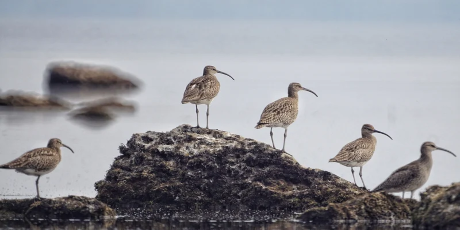How the curlew bird became Ireland's poster child for extinction 26 Apr 2023

Analysis: every day we lose another Curlew, is a day closer to the permanent loss of a bird so engrained in Irish culture and heritage - Dr. Paul Holloway, Department of Geography and Environmental Research Institute, UCC
The Curlew is steeped in natural and cultural heritage in Ireland. Their distinctive call has long been associated with the arrival of spring, so much so that the Curlew's cry is listed as expressing a yearning sense of 'home’ in the 1982 Harp Lager advertisement. Their distinctive call has been immortalised in writing by W.B. Yeats, and there is even a mountain range in Connacht called The Curlew Mountains (although the origins of the name are debatable).
More melancholic associations in folklore include the Seven Whistlers, whereby the nocturnal cry of the Curlew signalled an impending disaster; however, it is the Curlew itself that is at risk of becoming a nostalgic memory of the Irish landscape.
There are currently only 103 breeding pairs of Curlew remaining in Ireland, which represents a 98% decline in population in the last 30 years. The situation is not much better in Northern Ireland, with estimates as low as 250 pairs. We are facing the very realistic possibility that this bird could go extinct from our shores in our lifetime. Unfortunately, the Curlew is now entering a new stage of Irish heritage, notably as the poster child for extinction. It is so synonymous with extinction that it is on the front cover of the recent Report of the Citizen’s Assembly on Biodiversity Loss.
These figures are sobering but are often met with surprise, for we can often observe large flocks of 500-1000 Curlew on estuaries, fields, and open greenspaces throughout the winter. This is because during the winter months our populations are joined by their UK and Scandinavian cousins due to the favourable conditions of the Irish coastline, perhaps masking the drastic fall in the Irish population.
However, wintering populations also continue to drop year-on-year (a 43% decline over the last 23 years). The cautionary tale of the Passenger Pigeon should ring alarm bells. Once estimated in the 1800s to total between 3-5 billion birds, it was extinct in the wild by 1900.
Why are populations declining?
Coastal squeeze, which is where human-built structures prevent a natural landward transgression of habitats in response to sea-level rise, such as estuaries and salt marshes, are resulting in many of the prime habitats for Curlew simply disappearing. When this is coupled with the pressures at their breeding sites, including the conversion of open moorland, rough pastures, and meadows to urban developments, intensive agriculture, and more recently afforestation, the amount of space left for the Curlew is rapidly diminishing.
Afforestation, while necessary for carbon sequestration, can bring predators. Foxes, crows, and magpies are particularly lethal to the ground-nesting chicks and eggs, and are found in high abundance in the non-native coniferous plantations that are more commonplace in Ireland. Similarly, recent cases of disturbances by dogs have contributed to birds abandoning nesting sites, while in the UK a woman was even charged with the destruction of Curlew eggs by her dog.
Is it too late to turn the tide?
No. Here we can look to New Zealand and in particular the Black Robin. In 1976, only seven individuals, and one fertile female remained. With strong state intervention and the removal of predators from the island, there now total 300 individuals. State intervention, cooperation with landowners, and support work by conservation organisations will therefore be key to the survival of Curlew on the island of Ireland. In fact, 2022 was a record-breaking year for Curlew fledglings in Northern Ireland.
Our work through ECHOES has identified that many birds are utilising a much wider range of coastal areas in the winter than previously thought, travelling greater distances inland to forage for earthworms and roost away from predators. Their primary habitat near the coast is still of paramount importance to their survival, but large grasslands and fields inland are equally important.
Smaller fields that are surrounded by hedgerows and forests, or that are intersected by roads or footpaths, are being avoided, most likely due to predation and disturbance, respectively. This could potentially require a targeted approach to land management in the goal of Net Zero and Carbon Capture, with a realisation that uniform afforestation policies may not support the survival of one of Ireland’s most vulnerable birds.
What can we do to support these birds?
Connectedness with nature and a willingness to talk about the natural world has become somewhat of an afterthought in modern life. This was evidenced when we began to ‘hear the birds’ again during the early pandemic. By giving ourselves permission to reconnect with the natural world, we can observe behavioural shifts to support biodiversity. So, tell a friend about the plight of the Curlew, start the conversation, and see how many people are reminded of the bird so common less than a generation ago.
Next time you’re at the beach, near an estuary or a large green field (let’s face it, we’re never too far away from one), take a moment. Can you see or hear the Curlew, or any biodiversity for that matter? Reducing disturbance at the coastline and roost sites, such as sticking to designated paths, keeping dogs on leads, or animals indoors at night will support conservation for the Curlew and many other ground-nesting birds.
These small individual decisions can result in a butterfly effect that could ultimately increase fitness and breeding success of a single bird. Not every day has to be World Curlew Day, but we do need to start reminding ourselves that every day we lose another Curlew, is a day closer to a permanent loss of a bird so engrained in Irish culture and heritage.
ECHOES, a collaborative international project is funded through the Ireland-Wales Programme 2014-2020 and part-funded by the European Regional Development Fund through the Welsh Government.